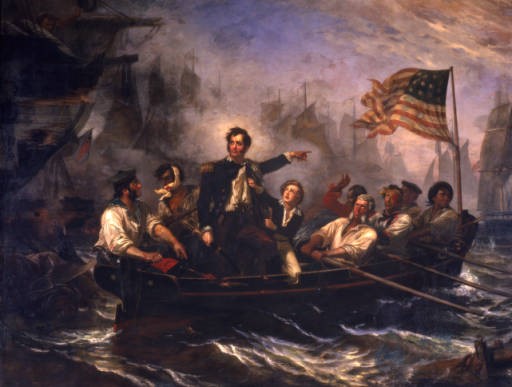The Battle of Lake Erie through Erie’s eyes

Ohio History Central
October 28, 2022
September 10, 1813—American and British forces duel in Put-In-Bay for control over Lake Erie.
The fight for control began during the War of 1812 and the invasion of British forces into the great lake’s region, and especially Lake Erie. The British forces were able to capture Fort Detroit through Lake Erie, causing the United States to act and protect the homeland.
The American Navy began frantically assembling ships in the harbor of Lake Erie. By mid-July 1813 they had built nine ships all together, six of which were small single gun ships and two flag ships the Lawrence and the Niagara.
The American Navy would have nine ships posted in Lake Erie—compared to the British six ships. Although the Americans had more ships, the British arsenal was superior and overpowering.
Despite the British Navy being a far more superior Navy with more advanced weaponry—the United States had Commander Oliver Hazard Perry to lead them into battle.
“As the days of June stretched on, Oliver Perry waited impatiently for the final consignments of munitions and men to arrive, so that he could weigh anchor and take his ships out to battle.”
The British had Commander Robert Barclay, who was under the orders of the Royal Navy. Barclay was sent out to handle the ships on Presque Ilse and sought out approval from his chain of command to pursue action.
“Barclay was still intent on putting his plan for dealing with the American shipyard at Presque Isle into action. The lack of suitable reinforcements was only one factor that interfered with his intentions, however.”
The conflict was that the British were in American waters, taking control of American fortifications. The United States built their ships and Navy in Erie as fast as they could, but British forces held a blockade and prevented them from firing cannons at the ships while they were being built.
A sandbar was built for the safety of the Americans to block the incoming cannons and protect the vessels being constructed.
“Due to the bar, the British ships could not enter Erie harbor while the American fleet was still under construction… beginning on August 1, Perry moved his fleet over the bar.”
After constant firing against the American ships, blocked by the sandbar the British found poor weather and supply shortages and began to retreat at the end of July.
This allowed for the newly constructed American fleet to move out of the sandbar and set up and organize in Put-In-Bay. As they moved into this new location, preparations for a fight began.
Here at Put-In-Bay, Perry and his squadron moved out of their secure location to dock and waited for the incoming British to arrive.
The dawn of September 10, 1813—the United States began to see British ships moving closer ready for battle.
The forward attack caused the Americans to charge forward and defend their land. The Americans met their match that day, with the British having superior fire power. The United States had something the British did not though—they had more firepower.
With the difference in weapon range, Perry ordered the flag ships to set full sail towards the British line. The Lawrence let Perry down and did not hold up as well as he would have hoped.
Walter Rybka, Capt. U.S. Brig Niagara describes the destruction of the Lawrence to be a great loss and, “With both guns and crew gone, there was nothing more that could be accomplished from the Lawrence.”
This allowed the Niagara to be the main flagship—the Niagara would lead the United States into victory and a surrender form the British Navy. The victory returned Fort Detroit and the Lake Erie territories to the United States. They also gained British ships.
“The British were never able to reestablish their power in the West, and the United States was able to secure its northern frontier.”, says Rybka.





